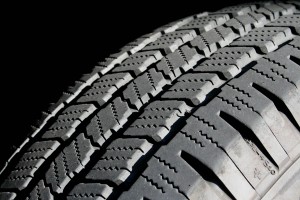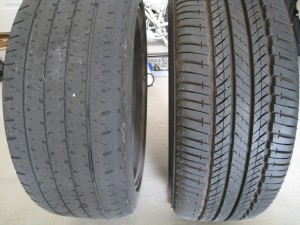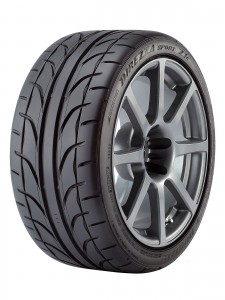

Any time I park in a public place, I get out of my car and the first thing I notice are the tires of the cars I parked near. I look first to see what the tread design is. This will indicate what the tires are designed to do. I then look at the car they’re on to see if they seem like a match. They often don’t. After tread design I look at tread direction. You’d be shocked how often I see tires that are meant to spin only in one direction, mounted backwards. Finally I look at tread depth (remaining tread on the tire). Many people think this is some kind of precision voodoo which has to be measured using a micrometer… or a quarter. Something about the tread covering Washington’s head… No. One glance from 10 yards away and I’ll tell you if the tire aught to be replaced. Either you have as much tread as you should, or your stingy and stupid and you don’t.
Digression: I also use this method to determine who I shouldn’t park next to. Tires are the most important thing on a car. If someone’s tires are mounted backwards, wrong for the season, or nearly bald, it indicates that they don’t care for their car and are therefor likely to slam a door into mine or scrape it while pulling out.
The first thing to know is that you should have directional tires. This is a simple fact but the reason most people don’t is that they don’t care about road safety (or at least don’t understand it). Directional tires cannot be rotated every 7500 miles the way you’re supposed to with omnidirectional tires. Normally during a tires life, it will see duty on each corner of the car. This allows all the tires to wear evenly and makes it so you can run them longer before replacement. Directional tires can only be run on the right or left of the car. The tire has a designated inside and outside so a tire on the left rear can only be rotated between the left front and rear. It should never see duty on the right of the car because it would have to be mounted backwards.

For most of the world there are distinct seasons. Usually one of them involves white stuff falling from the sky. That’s called snow. I’m telling you this because if you need to read a tire guide you may have failed elementary school and might have been wondering what it was. If you’re also wondering why it’s cold, that because water droplets form in the clouds and during the winter the temperatures in the air are low enough that it freezes into ice crystals. Ice is cold… but I digress…
Every driver, regardless of driving style or vehicle, should have two sets of tires. One for winter, and one for the rest of the year. A lot of people think that systems like VDC and ABS are especially helpful in the winter. Not if you have junk all-season tires on your car… Your car’s power and its control systems are only as good as your traction, and you have none in the white fluffy stuff. Around late November everyone with a car should be switching over to dedicated snow tires. There are many levels of snow tire and again it has a lot to do with if you can stomach replacing them more often. As a rule of thumb with all tires, the more effective they are, the more often they must be replaced. General winter tires are made to give you good handling on snow and on plowed winter pavement. General winters, however, are nowhere near as effective as a dedicated snow tire. Dedicated snow tires give you so much grip in snow that you’d think you’re just driving in the rain. You can brake hard and turn harder with a snow tire, and unlike with all-season or summer tires, once you break traction you actually have a chance of regaining control before that oncoming snow bank. Dedicated snow tires are also good on pavement in the winter because they are extremely soft, giving them high levels of grip in the cold. The only issue is that that softness leads to the tires wearing quickly when you’re not driving on snow. Ideally you should run snow tires from the end of November to the middle of March, then get them off. If you use them in the warmer seasons, the rubber becomes too soft and will wear like a pencil eraser and there will be little grip to speak of.
Winter tires make sense to many people, even if they stupidly don’t want to spend the money for them. Summer tires on the other hand are a mystery to most. There is a general lack of understanding regarding the differences between warm season tires. There are all-seasons, but those are exactly that. They are mediocre at everything. They’re not good in snow, they’re not great at shedding rain water, and they’re not very grippy in the dry. If you’re smart, this should be a non-issue because you bought snow tires and therefore don’t need junk all-seasons. Now you can buy proper summer tires. A good set of summer tires may have so much grip that they can reduce stopping distances (from 60mph) by over 25ft over a car’s factory tires. Now a car that had been rated to do 60-0 in 140ft might do it in 115ft. That could easily be the difference between participating in the pileup in front of you, and simply swerving around it. Dedicated, direction summer tires are what you should be running when you don’t have snow tires on your car. They massively increase your grip threshold, and to the normal driver, that means your ABS is more effective, your stopping distance is shorter, your ability to avoid an accident is greater, and when things really go bad, your vehicle dynamic control system should have a 10-20% better chance of getting you out of it.
The point is, if you’re performance-minded, this should all be a no-brainer. If you’re safety minded, you probably spent too much time looking at safety ratings and the number of airbags when you were car shopping. The better plan is to simply avoid the accident through increased traction. If your absent minded, please contact me with your address. I will look up the nearest RMV and give you directions so you can go turn in your license. You can only be one of the three. So, which one are you?

2 Comments